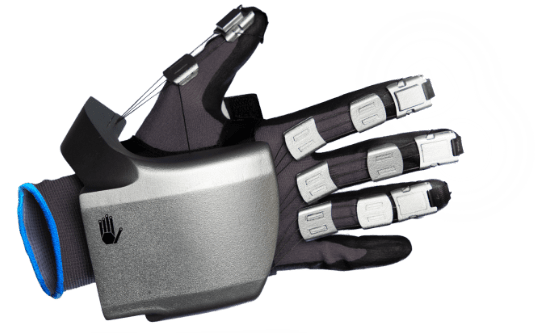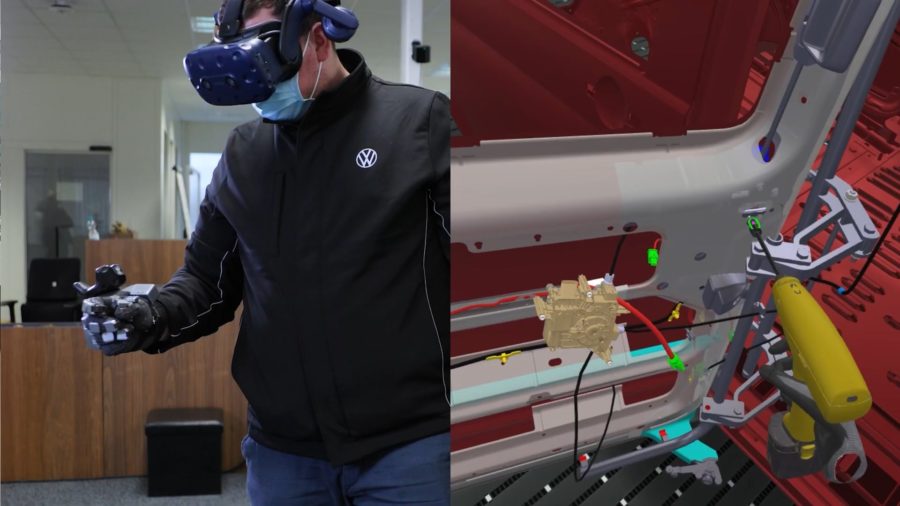April 21, 2022 – SenseGlove, a developer of force feedback gloves for virtual reality (VR), has this week unveiled the results of a SenseGlove case study conducted in cooperation with Volkswagen Commercial Vehicles, a manufacturer of light commercial vehicles.
SenseGlove Nova is a haptic force-feedback glove designed specifically for professional VR training purposes. Volkswagen Commercial Vehicles implemented and tested SenseGlove Nova for automotive VR training in assembling a Volkswagen T6 door in order to improve the realism of VR simulation and to protect the expensive vehicles from damage that could potentially occur during on-hands training. Assembly line trainees who donned SenseGlove Nova haptic force feedback gloves in a virtual environment were able to physically feel the virtual parts of the vehicle, explore the details of the virtual door, and interact with them in a natural way.
SenseGlove Nova features a flexible form-factor in combination with haptic technologies and hand tracking that enables users to feel shapes, textures, stiffness, impacts and resistance in virtual reality. Nova’s touch-enabling technology can be used to upscale all kinds of VR training programs, such as training to handle hazardous materials, carrying out complex tasks with multiple tools and objects, and learning to design and test physical prototypes.

According to SenseGlove, Volkswagen Commercial Vehicles has experimented with VR and haptics for the past few years in order to improve the efficiency of its pre-training program and save time. VR enables Volkswagen employees to train from any location without the need to visit the company’s professional showroom to access vehicles. The combination of haptic gloves in combination with VR helps to increase the realism of VR training and allows trainees to get familiar with the equipment at an early stage of production.
“We want to make the pre-training as realistic as possible for two reasons. First, it saves time. The employees from the line do not have to come to our physical location to train; they can experience it in VR. Second, it enables us to keep the expensive pre-series vehicles we need here in the professional showroom in order to qualify the employees,” said Friedrich Mattiszik, Head of Production System at Volkswagen.
Volkswagen Commercial Vehicles began testing SenseGlove Nova in 2021 in an effort to compare traditional VR training with controllers to VR training that uses haptic force-feedback gloves. Traditional VR training allowed Volkswagen to protect the training equipment from being damaged, however it did not allow trainees to interact naturally. Additionally, the need to continuously keep the controllers in the user’s hands meant trainees were unable to grab things, let them go again or feel the details of different sizes in their hands.

“One hundred percent of the trainees who completed the T6 vehicle assembly training found it more realistic to work with SenseGlove Nova versus the controller, simply because they could do more, like grabbing things. It just feels more realistic,” added Marcos Antelo Barrio, Trainer at Volkswagen.
The feeling of realistic physical interaction is possible due to the combination of SenseGlove’s force feedback, vibrotactile feedback and motion capture features. The force-feedback gloves allow those in assembly training to:
- Feel the parts of equipment that need to be assembled;
- Ascertain the difference between the sizes and density of each part;
- Feel every impact when they connect or insert parts;
- Feel vibration when they work with a drilling machine.
Combined with motion capture, the features allow trainees to interact in a similar way as they would in a physical training, according to SenseGlove.
SenseGlove launched its inaugural haptic feedback glove, the DK1 in 2018, and the second iteration, the SenseGlove Nova at CES 2021. The company states that its products have since been purchased and applied by more than 100 corporations and institutions, including Volkswagen, the European Space Agency, the Royal Dutch Army, Airbus, Scania, Procter & Gamble, Siemens, Cambridge University and Fraunhofer.
For more information on SenseGlove and its force feedback gloves for virtual reality, please visit the company’s website.
Full video shown below.
Image / video credit: SenseGlove / YouTube
About the author
Sam is the Founder and Managing Editor of Auganix. With a background in research and report writing, he has been covering XR industry news for the past seven years.
